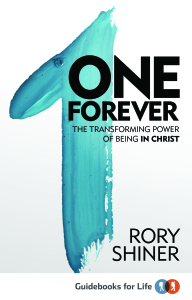What union with Christ means: review of One Forever
 One Forever: the transforming power of being in Christ, Rory Shiner
One Forever: the transforming power of being in Christ, Rory Shiner
It’s easy to skip over the little things. And little words like “in” and “him”.
These little words, however, punctuate the New Testament, especially Paul’s letters (e.g. Ephesians 1; Colossians 2). In this short book, Rory Shiner shows how the little words ‘in Him’ describe a central (but often forgotten) New Testament teaching of our union with Christ.
The book covers a vast scope in its seven chapters—from creation to new creation. In the opening chapters (creation and incarnation), we are drawn into the big picture of God’s work in the world. In particular we are shown the pattern of “unity in diversity” that is seen in creation, marriage, and Christ.
The central chapters (salvation and justification) delve into the topics where union with Christ is most commonly thought about. Chapter three (salvation) uses many helpful illustrations to describe what it means to be “in Christ”, some are biblical (a vine and branches, a body), and other much more modern (being in an aeroplane will be a spiritual experience after reading this book).
In chapter four (justification) we see how some of the suspicions that we have when we think about justification by faith (the Bible’s teaching that God is both just and the justifier of the ungodly, Romans 3:26; 4:5) can be addressed through a proper understanding of being “in Christ”. As just one example – justification by faith has been accused of being a legal fiction (how can someone be justly punished in the place of another), but when we understand that we are united to Christ by faith, we realise that believers don’t just appear to be justified, we really are.
In the final three chapters the book is at its most practical. Shiner discusses how the theology developed in the opening chapters impacts our struggle with sin, the importance of church, and living in the light of the resurrection. If you struggle at times navigating the theological river of the book’s opening, these chapters give firm ground to anchor the theology in real life.
There are hints of how being “in Christ” enables us to live for Jesus when tempted with gossip or greed (chapter five). Chapter six considers how union with Christ changes the way we serve his Body, the Church. Finally, chapter seven assures believers in the hope of joining with Christ’s resurrection, and considers (for example) how this changes our response to fleeting, sinful temptation.
Although the book keeps to its promise of showing how being “in Christ” makes a world of difference ‘on Tuesday’, there are plenty of places where more practical reflection could have been hinted at. I would have loved to have heard, for example, about how Jesus’ incarnation interacts with (bio)ethics, or how union with Christ shape the union of marriage. However, in such a brief book not everything can be said. Another critique is that, although this reviewer enjoyed the journey from the ‘big picture’ approach, some readers may find this disorientating. It may have been less risky to begin the book in a more expected place (relating our ‘in Christ-ness’ to salvation and justification), which would be more familiar, though less majestic.
Coming from Matthias Media’s series of Guidebooks for Life, this book aims to both dig deep into the Bible (and theology) whilst applying these reflections to real life. Despite it’s brevity (88 pages) One Forever masterfully achieves both these goals. What it says will help you to notice the little things in the Bible that you may have previously skipped over, and also spark your thinking about how to live because you are in Christ.
Daniel Saunders is Assistant Minister at Centenary Presbyterian Church in Queensland.
Email This Story
Why not send this to a friend?


